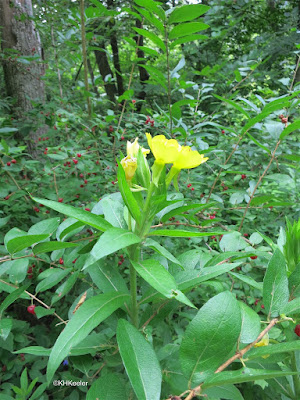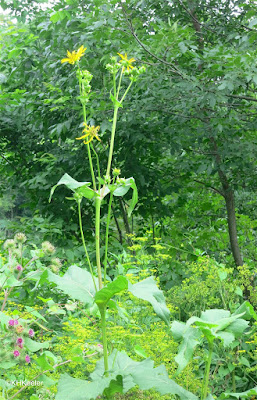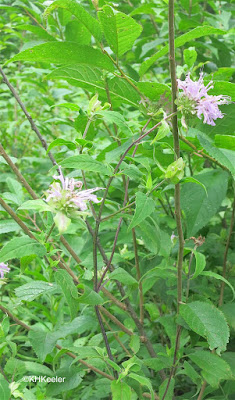I took a field trip to Forestville/ Mystery Cave State Park during the Botanical Society of America meetings (meeting post). It is a reserve in the driftless region, places the glaciers somehow missed. The glaciers nevertheless rearranged the area, as rivers of meltwater cut deep channels and, slowing, dropped everything from sand to boulders.
Today the area is at the western edge of the great Eastern Deciduous Forest that covered the eastern United States. The forest in Forestville is secondary growth, having been farmland in the 1890s, but progressively abandoned thereafter, officially designated a state park in the 1960s. Minnesota Parks has making a concerted effort to remove weeds and favor native plants. Experts can show you the imperfections, but to a casual visitor, it is a lovely forest.
I grew up in the forests of New York and Ohio but I have been gone many years. It was a delight to see old friends such as jewelweed. I had a favorite leaning willow tree where as a preteen in upstate New York I sat and read. Jewelweed grew below it and hummingbirds would buzz in, pollinating the flowers.
 |
| pale touch-me-not, Impatiens pallida |
The name touch-me-not applies to a characteristic of both species: when the seeds are ripe, if you bump the seed pod, it snaps open and throws the seeds several feet from the plant. Of course that was one of my favorite characteristics of the plant: I loved pinching the seedpods to explode them. Alas I saw no ripe pods during the hike.
Another old friend along the trail was the common evening primrose, Oenothera biennis (evening primrose family Onagraceae). It is a widespread native biennial, a rosette of leaves the first year, a tall flowering stalk with big yellow flowers the second year. This one was close to five feet high.
 |
| common evening primrose, Oeothera biennis |
 |
| Queen Ann's lace, Daucus carota |
 |
| cup plant, Silphium perfoliatum with author for scale |
 |
| cup plant, Silphium perfoliatum |
The rock walls and their pools were also very beautiful.
For contrast we climbed to the top of the hill (and mighty steep it was) coming out onto rocky hilltops which harbored small patches of prairie, protected from being overtaken by trees by the shallow rocky soil.
I particularly like milkweeds, so I noticed this one, the whorled milkweed, Asclepias verticillata (dogbane family, Apocynanceae)
 |
| whorled milkweed, Asclepias verticillata |
And there were all these cheerful coneflowers, the gray-headed coneflower or pinnate prairie coneflower, Ratibida pinnata (sunflower family, Asteraceae):
 |
| pinnate prairie coneflower, Ratibita pinnata |
 |
| "See those other hills, the prairie vegetation is found there too," we say properly, carefully standing in the spot where the cold air came up from the valley |
Staghorn sumac, Rhus typhina, (cashew family, Anacardiaceae), a common shrub of the eastern half of the U.S.
and
wild bergamot, Monarda fistulosa (mint family Lamiaceae). This is a native mint with a nice minty smell to the leaves and pretty flowers that attract bees and butterflies. (This is not the bergamot used in English breakfast tea. See post on bergamot).
A lovely park, wonderful hike and terrific plants.
Comments and corrections welcome
References
Moyle, J. B. and E. W. Moyle,. 2001. Northland Wildflowers. revised edition. University of Minnesota Press, Minneapolis Minnesota.
USDA Plants website http:/plants.usda.gov accessed 8/16/18
Related posts on this blog
Evening primroses--Names and Relations link
Evening primroses--Beautiful Wherever You Meet Them link
Milkweeds-- Just a Glimpse of Milkweed Diversity link
Comments and corrections welcome
References
Moyle, J. B. and E. W. Moyle,. 2001. Northland Wildflowers. revised edition. University of Minnesota Press, Minneapolis Minnesota.
USDA Plants website http:/plants.usda.gov accessed 8/16/18
Related posts on this blog
Evening primroses--Names and Relations link
Evening primroses--Beautiful Wherever You Meet Them link
Milkweeds-- Just a Glimpse of Milkweed Diversity link
Kathy Keeler, A Wandering Botanist
More at awanderingbotanist.com
Join me on Facebook: https://www.facebook.com/AWanderingBotanist






No comments:
Post a Comment